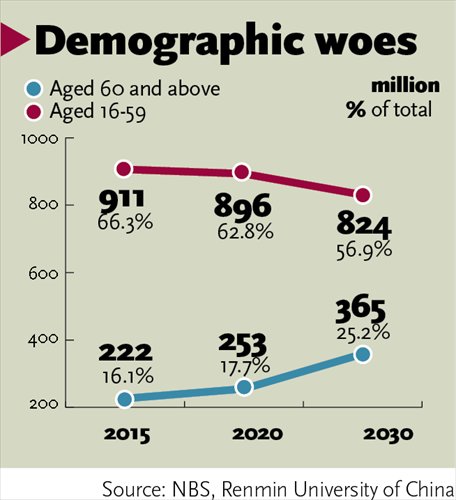China's workforce to decline to 57% in 2030, warn experts
Shrinking labor pool unable to fully propel economy forward: expert

Graphics: GT
China will face severe demographic challenges in the next 15 years as the country's working-age population is predicted to shrink from last year's 66.3 percent to 56.9 percent of the total in 2030.
The aging population will swell from 16.1 to 25.2 percent which could seriously test China's social and economic development, experts said.
The number of those aged between 16 and 59 will decrease to 896 million in 2020 and 824 million in 2030, while those aged 60 and over will grow to 253 million in 2020 and 365 million in 2030, according to new data provided by the Population and Development Studies Center at the Renmin University of China to the Global Times on Tuesday.
Data from the National Bureau of Statistics (NBS) shows that in 2015, China's working age population was 911 million and there were 222 million senior citizens.
"China's current demographic structure is severely distorted, as the country now faces problems such as low fertility, an aging society and gender imbalance. This may hinder economic development as well as social stability in the long run," said Mu Guangzong, a professor at Peking University's Institute of Population Research.
Yi Fuxian, a controversial scientist at the University of Wisconsin-Madison in the US, recently warned at the Boao Forum for Asia on March 25 that China has entered a "low fertility trap" and that its aging population will impede economic development, using his own data.
"China will never overtake America's economy, because of the decrease in the labor force and the aging of the population," Yi was quoted as saying by the New York Times on March 23.
Although other scholars are reluctant to jump to similar conclusions, many worry that the demographic problem may worsen if the nation does not take more decisive action.
"China's aging society won't be stopped by policies such as allowing a second child. The country should ensure its transition from low-skilled manufacturing to a tech-intensive economy, as well as establishing a proper old-age social security system to counter the upcoming population problems," said Zhai Zhenwu, chairman of the standing council of the China Population Association, and dean of the School of Sociology and Population Studies, Renmin University of China.
Aggravated population structure
Liang Zhongtang, a former expert with the National Population and Family Planning Commission and a research fellow at the Shanghai Academy of Social Science said he believes China's labor pool will keep shrinking in the next few decades.
The cheap labor available in China after its reform and opening-up sparked a sustained economic boom, but as the generation of the country's family planning policies came of age, the once inexhaustible supply of laborers began to dry up.
The working age population first declined in 2012, dropping 0.6 percent from the year before, and it has shrunk year-on-year since. It was 26 million less in 2015 than 2012, according to the NBS.
There are already labor shortages in many Chinese cities including in China's manufacturing powerhouse of Guangdong Province. Manufacturers in Dongguan in the province are short 200,000 workers, even though the city's minimum salary doubled between 2010 and 2015, the Xinhua News Agency reported.
At the opposite end of the spectrum, the number of Chinese seniors is increasing rapidly.
"There was a decade-long population boom since 1962 and these people will reach retirement age soon … adding more than 20 million seniors per year," Liang said.
This aging population has prompted more demand for elder care services. According to a PricewaterhouseCoopers report in December, Chinese people will spend over 10 trillion yuan ($1.54 trillion) from 2016 to 2020 on care, increasing 17 percent annually.
"A rapidly aging population and a declining manpower pool will dampen China's economic development, as well as raise challenges for the country's current social security system and care services," Zhai said.
Economic downturn
The decline in the working age population and surging salaries will adversely impact China's labor-intensive economy, with manufacturing, particularly low-end factories producing toys and clothes severely affected, experts said.
"China's economic downturn in recent years was related to the country's imbalanced population," Mu told the Global Times.
"China's shrinking labor pool cannot fully propel China's economy forward, and the country's ability to innovate will also be affected," he added.
The decline of the marriageable population may lead to a real estate downturn in small and middle-sized cities, Zhai noted.
Despite the problems, Wang Pei'an, vice minister of the National Health and Family Planning Commission, said in January that China will stick to its family planning policy for another 20 or 30 years, given that China will have a large population for a long time.
"The government should ultimately abandon its family planning policy and let the people decide, as China's severe demographic structure will bring more uncertainties to the country's economy," Liang said.
Newspaper headline: Workforce to decline to 57% in 2030, warn experts